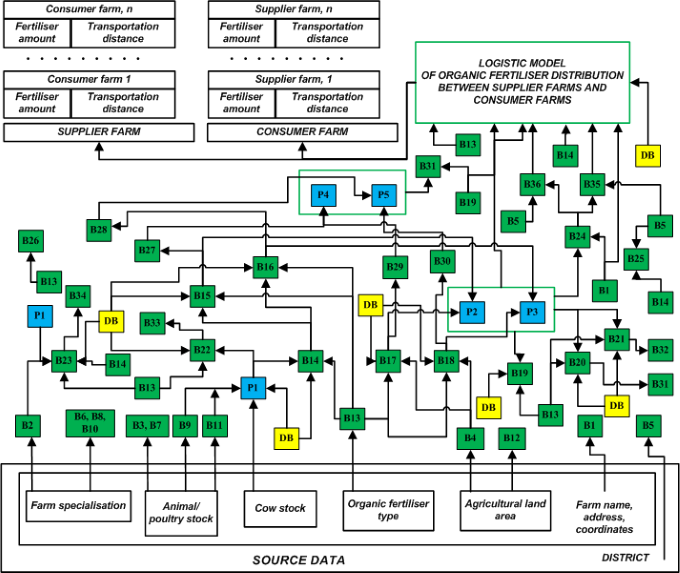Nutrient application planning

Well-planned use and distribution of manure decreases the risk for negative impact on waters. Tools for planning of nutrient use and fertilisation gives benefit for both the farmer and the environment.
Here a digital method for agro-monitoring and nutrient load management in the Russian part of the Baltic Sea catchment area is presented.
Priority tasks of the joint environmental activity in the Baltic region include nutrient load monitoring and development of measures aimed at its reduction.
The main function of an interactive programme is monitoring of livestock/poultry waste management to coordinate use of organic fertilizers considering environmental and ecological data.
The programme monitors the farm generation of nutrients (nitrogen and phosphorus) in the organic fertilizers and creates the logistical scheme of their application with due account for environmental and economic factors.
The functional objectives of the interactive programme are:
- To receive the relevant source information on the region, agricultural organisations, applied animal/poultry manure handling technologies, and manure storage types.
- To visualize all agricultural organisations on a digital map: location, name, specialisation, animal stock, available agricultural land.
- To calculate and display the current situation in agricultural enterprises: amount of organic fertilizer received, land sufficiency for all organic fertilizer application, and required volume of manure storages and composting pads.
- To calculate and display the forecast situation in agricultural organisations.
- To create the electronic passports of farms, districts and regions, including the logistics of organic fertilizers distribution from supplier farms to consumer farms, considering the nutrient load standards and the data on the nutrient load distribution within the boundaries of agricultural lands in the catchment area.
Localisation and implementation
The digital maps based on a selected geographic information system are used to position the farms and to determine the inter-farm relationships in terms of organic fertilizer distribution. This way the programming resources are combined with spatial visualisation, and the agro-monitoring and nutrient load management are made interactive.
The mathematical model for limiting the nutrients introduction per one hectare of agricultural land was adopted as the basis to create a forecasting system and a logistic scheme for organic fertilizers distribution.
The limiting factor in the fertilizer application dose is total nitrogen (170 kg/ha) and total phosphorus (25 kg/ha). When one of the indicators reaches the limit value, the programme will give a signal. The indicator (total nitrogen or total phosphorus) the limit value of which is reached first is considered the most significant in the calculation of the organic fertilizer application dose.
Effects, duration and maintenance
The programme makes it possible to manage the nutrients and to monitor the expected reduction of diffuse load from agricultural production on the Baltic Sea. As a result, all produced organic fertilizers are distributed over the agricultural land that reduces the diffuse load in the Baltic Sea Region.
The programme is free for relevant executive authorities and agricultural enterprises. The effects are noticeable as long as the programme is used. After implementation, the programme requires regular data updates for optimal operation.

Nutrient application planning - extended description
Description
The programme is mainly aimed at information support for executive authorities and managers of agricultural enterprises in terms of environmental and production efficiency improvement within preparation and use of organic fertilisers in agriculture.
The programme fulfills the following functions:
- keeping the database and displaying the current situation in relation to agricultural organisations on the map based on the following parameters:
- livestock (increase, decrease);
- enterprise’s focus area;
- area of agricultural lands available for organic fertilisers;
- applied technological solutions related to manure/droppings processing into organic fertilisers;
- organic fertiliser performances and parameters; - logistics of obtained organic fertilizer use: organic fertilizer distribution between supplying enterprises (produce more fertilisers than they need for their own fields) and consuming ones (need more fertilisers than they can produce);
- reporting documents’ drafting.
The programme makes it possible to manage nutrients and to monitor the expected reduction of diffuse load provided by agricultural production in the Baltic Sea area. As a result, all produced organic fertilisers are distributed over agricultural lands which reduces the diffuse load in the Baltic Sea region.
Biogenic elements are managed depending on specific conditions by changing optimisation criteria in the fertiliser distribution logistics model.
Effects
Promotes diffuse load reduction in the catchment area of the Baltic Sea region. As all organic fertilisers are distributed across agricultural lands considering the application rates for nitrogen and phosphorus:
- soil fertility increases;
- agricultural enterprises get planned yield;
- risk that nitrogen or phosphorus may get to waterbodies or groundwaters reduces;
- due application (and not storage) of organic fertilisers reduces pollutant emissions to atmosphere;
- increased volumes of liquid organic fertilisers reduce risks of agricultural land water logging.
Nutrient application planning - links to resources
Pamphlets, reports, videos and websites
-
Scientific papers
Aleksandr Briukhanov, Alexey Dorokhov, Ekaterina Shalavina, Alexey Trifanov, Ekaterina Vorobyeva and Eduard Vasilev Digital Methods for Agro-Monitoring and Nutrient Load Management in the Russian Part of the Baltic Sea Catchment Area // IOP Conference Series: Earth and Environmental Science 578 (2020) 012011.
Authors:
Aleksandr Briukhanov, Ekaterina Shalavina, Ekaterina Vorobyeva and Eduard Vasilev. Federal Scientific Agriengineering Centre VIM, St Petersburg, Russia.
Contact:
Eduard Vasilev, Federal Scientific Agriengineering Centre VIM, St Petersburg, Russia.

